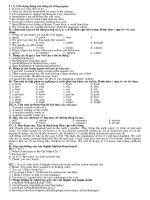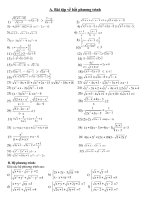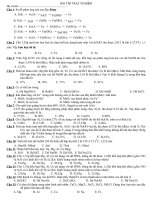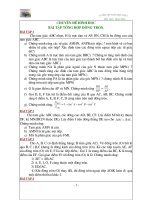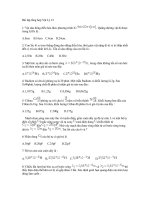Bài tập tổng hợp - C15
Bạn đang xem bản rút gọn của tài liệu. Xem và tải ngay bản đầy đủ của tài liệu tại đây (419.69 KB, 5 trang )
<span class='text_page_counter'>(1)</span><div class='page_container' data-page=1>
18. Shadduck JA, Albert DM, Niederkorn JY: 1981, Feline uveal
melanomas induced with feline sarcoma virus: potential
model of the human counterpart. J Natl Canc Inst 67:619–
627.
19. Stiles J, Bienzle D, Render JA, et al.: 1999, Use of nested
poly-merase chain reaction (PCR) for detection of retroviruses from
formalin-fixed, paraffin-embedded uveal melanomas in cats. Vet
Ophthalmol 2:113–116.
20. Tsatsanis C, Fulton R, Nishigaki K, et al.: 1994, Genetic
deter-minants of feline leukemia virus-induced lymphoid tumors:
pat-terns of proviral insertion and gene rearrangement. J Virol 68:
8296–8303.
J Vet Diagn Invest 14:343–347 (2002)
<b>Restriction fragment length polymorphism of porcine reproductive and respiratory</b>
<b>syndrome viruses recovered from Ontario farms, 1998–2000</b>
Hugh Y. Cai, Hazel Alexander, Susy Carman, Dara Lloyd, Gaylan Josephson, M. Grant Maxie
<b>Abstract.</b> From January 1998 to July 2000, 2,456 clinical samples, including lung, tonsil, lymph node, and
serum, from 760 cases submitted to the Animal Health Laboratory, Ontario, Canada, were tested for porcine
reproductive and respiratory syndrome viruses (PRRSV) using reverse transcriptase polymerase chain reaction
(RT-PCR) and RT-PCR product restriction fragment length polymorphism (RFLP) analysis. A total of 516
samples from 284 cases were PCR positive for the PRRSV open reading frame (ORF) 7 sequence. The
RT-PCR RFLP typing assay was performed using 2 different sets of primers, amplifying 716 or 933 base pairs of
ORF 4, 5, and 6 of PRRSV. Samples from 254 cases were typeable, yielding 34 different RFLP types. Of these,
164 cases had 32 different RFLP types of field or intermediate strains, 86 had a pattern similar to a commercial
PRRSV vaccine or VR 2332 strain of the virus, 4 had a RFLP type shared by another commercial vaccine and
a field strain. In 4 cases, 2 different RFLP types were identified from tissues from different pigs that were
submitted at the same time from the same farm. Of the 195 farms that submitted PRRSV PCR-positive samples,
48 submitted samples on more than 1 occasion during the specified time frame. In 23 of those 48 farms, RFLP
patterns of PRRSV differed between submissions, whereas in the other 25 farms, the RFLP pattern remained
unchanged. There were 34 different PRRSV patterns identified from 236 cases using the primer set amplifying
716 base pairs of PRRSV. There were 18 cases, consisting of 9 different patterns, typeable only by using the
primers amplifying a 933-base pair fragment of the virus.
Current methodologies used to detect porcine reproductive
and respiratory syndrome virus (PRRSV) infection include
1) virus isolation; (2) antibody detection, e.g., indirect
im-munofluorescence, indirect immunoperoxidase monolayer
assay, enzyme-linked immunoasorbent assay, and virus
neu-tralization; 3) antigen detection, e.g., immunohistochemistry
and immunofluorescence tests on tissue samples; 4) viral
nu-cleic acid detection, e.g., reverse transcriptase polymerase
chain reaction (RT-PCR) for detection and RT-PCR product
restriction fragment length polymorphism (RFLP) analysis
for strain typing.3 <sub>Primers from the open reading frame</sub>
(ORF) 7 (nucleocapsid gene) of PRRSV have been shown
to be specific for detection of all North American and
Eu-ropean isolates.2 <sub>In addition to detection of the virus, </sub>
RT-PCR RFLP typing methods have been developed that make
it possible to differentiate different field strains and the
com-mercial vaccine.4 <sub>The current study detected and typed</sub>
PRRSV using PCR-based methods from clinical samples
ob-From the Animal Health Laboratory, Laboratory Services
Divi-sion, University of Guelph, Box 3612, Guelph, Ontario N1H 6R8,
Canada.
Received for publication June 12, 2001.
tained from Ontario swine herds from January 1998 to July
2000.
Clinical samples, including lung, tonsil, lymph node, and
serum were submitted to the diagnostic lab from pigs with
clinical signs of respiratory disease and histologic evidence
of interstitial pneumonia or from aborted fetuses. Pieces
(0.25 g) of frozen tissues were homogenized using an
hom-ogenizera<sub>in guanidinium thiocyanate</sub>b <sub>solution as described</sub>
previously.1 <sub>The homogenate was frozen and thawed to</sub>
break the tissue cells, then subjected to RNA extraction
us-ing a commercial RNA extraction kit.c<sub>Serum was subjected</sub>
directly to RNA extraction using a commercial RNA
extrac-tion kit.d
To detect the virus, a 1-tube RT-PCR was performed by
amplifying 433 base pairs (bp) of ORF 7. The primers
(1010PLS/1010PLR) used were described previously,2 <sub>with</sub>
the exception of a 5⬘addition of a G on the upstream primer.
This primer set was reported as being specific for the ORF
7 region of both North American and European strains. The
RT-PCR was carried out in a 25-l reaction mix containing
2 mM MgCl2,e 0.2 mM of each dNTP,e 0.4 U/L RNase
inhibitor,e <sub>1.0 U/</sub><sub>l MuLV reverse transcriptase,</sub>e <sub>0.05 U/</sub><sub>l</sub>
<i>Taq DNA polymerase,</i>e<sub>0.1</sub><sub>M of each primer,</sub>f<sub>and 2</sub><sub>l of</sub>
</div>
<span class='text_page_counter'>(2)</span><div class='page_container' data-page=2></div>
<span class='text_page_counter'>(3)</span><div class='page_container' data-page=3>
<b>Table 1.</b> Different RFLP types of PRRSV recovered from Ontario farms by the AHL from January 1988 to July 2000.*
RFLP type (no. of cases) % of total RFLP type (no. of cases) % of total
111 (1)
<b>112 (5)</b>
<b>114 (9)</b>
<b>122 (12)</b>
123 (9)
<b>124 (21)</b>
<b>132 (16)</b>
132 with deletion (1)
0.39
1.97
3.54
4.72
3.54
8.27
6.30
0.39
174 (3)
<b>212 (4)</b>
214 (1)
222 (2)
242 (1)
251 (1)
<b>252 (86)</b>
<b>254 (1)</b>
1.18
1.57
0.39
0.79
0.39
0.39
33.86
0.39
133 (4)
<b>134 (10)</b>
<b>142 (4)</b>
143 (3)
<b>144 (4)</b>
<b>151 (1)</b>
<b>152 (4)</b>
<b>153 (1)</b>
161 (1)
162 (3)
163 (3)
164 (1)
171 (1)
172 (10)
1.57
3.94
1.57
1.18
1.57
0.39
1.57
0.39
0.39
1.18
1.18
0.39
0.39
3.94
<b>262 (8)</b>
264 (3)
292 (1)
2-10-2 (1)
114† (3)
122† (1)
124† (3)
133† (1)
134† (3)
144† (2)
162† (2)
162† with deletion (1)
164† (2)
3.15
1.18
0.39
0.39
1.18
0.39
1.18
0.39
1.18
0.79
0.79
0.39
0.79
Total RFLP types 43
Total typeable cases 254
* The types in bold have been reported previously.4,5
† Typeable only by ORF5-933bp-RT-PCR typing method.
the following thermocycling programs: cDNA synthesis at
42 C for 20 min, inactivation of reverse transcriptase and
denaturation at 95 C for 3 min, 35 cycles of denaturation at
95 C for 20 sec, primer annealing at 60 C for 15 sec; and
primer extension at 72 C for 20 sec, final extension at 72 C
for 7 min, holding at 4 C. The PCR product was detected
by electrophoresis in a 1.5% agaroseg<sub>gel stained with </sub>
ethi-dium bromide.h
A previously described RT-PCR method4<sub>was modified to</sub>
amplify a 716-bp fragment of ORF 5 and part of ORF 4 and
6 (716-bp RT-PCR). The PCR mix was 50l in volume and
contained reagents in the same concentrations as above, with
the exception that 1.5 mM MgCl2, 0.2M of each primer,
and 4l of template were used. Hot start was achieved using
a wax beadi <i><sub>to separate the Taq DNA polymerase from the</sub></i>
rest of the reagents. The RT-PCR cycle parameters were
sim-ilar to above except primer extension time was lengthened
to 30 sec. If no amplicon was generated by the 716-bp
RT-PCR, a second method was used to amplify a 933-bp region,
including 47 bp upstream to 170 bp downstream of the
above 716-bp fragment (933-bp PCR). The 933-bp
RT-PCR was identical to that of 716-bp RT-RT-PCR except for the
primer sequence used, i.e., forward primer 5⬘-GAC ACC
TGA GAC CAT GAG and reverse primer 5⬘-TCT ATG GCT
GAG TAC ACC. After 716-bp RT-PCR or 933-bp RT-PCR,
10<i>l of product was digested with MluI, HincII, and SacII</i>
separately at 37 C for 2 hr as described by the manufacturer.j
The samples were electrophoresed through a 2%
high-strength agarosek <sub>gel and visualized by staining with </sub>
ethi-dium bromide. Fragment size was determined against a
100-bp DNA ladder.j <sub>The code representing a digested pattern</sub>
was assigned according to or adapted from those described
previously.4 <sub>For example, a PRRSV strain was assigned as</sub>
<i>type 2-5-2 if its RT-PCR amplicon was digested by MluI and</i>
<i>generated 279- and 437-bp fragments, by HincII and </i>
<i>gen-erated 327- and 389-bp fragments, and by SacII and </i>
gener-ated 53- and 663-bp fragments. As defined previously,5 <sub>a</sub>
field strain has 2 or more restriction enzyme sites different
from a vaccine strain (type 2-5-2) and an intermediate strain
has only 1 site different within ORF 5.
Figure 1 shows examples of the PRRSV RFLP types
iden-tified in this study. The different RFLP types of PRRSV
recovered from Ontario farms from January 1998 to July
2000 are summarized in Table 1. A total of 2,456 samples
from 760 submitted cases were analyzed. Of these, 516
(20.3%) samples from 284 cases (37.4%) were PRRSV ORF
7-sequence positive. Of these 284 PRRSV-positive cases,
254 were typeable and 30 cases were nontypeable. The 254
typeable cases consisted of 34 different RFLP types. Of
these 254 cases, 86 were type 2-5-2, similar to a commercial
vaccine1 <sub>or VR 2332 strain of PRRSV. The relationship of</sub>
these samples to the time when the herd was vaccinated was
not clear because of incomplete herd histories. Type 1-4-4,
an RFLP type shared by another commercial vaccinem <sub>and</sub>
a field strain, was detected in 4 cases. Samples from 164
cases had 32 different RFLP types of field or intermediate
strains. Two strains were identified with patterns similar to
1-3-2 or 1-6-2 separately except all digested and undigested
fragments were smaller in size. Further study is needed to
investigate whether this reflects a natural deletion in the
PRRSV genome.
</div>
<span class='text_page_counter'>(4)</span><div class='page_container' data-page=4>
<b>Table 2.</b> Twenty-three farms with different RFLP types of
PRRSV.
Farm Submit date Type
A 98/03/18
98/12/23
132
252
B 99/04/28
99/12/21
172
132
C 99/06/29
00/02/17
144*
161
D 98/01/07
98/08/31
242
153
E 99/09/20
99/09/20
212
112
F 98/10/08
98/11/19
99/06/30
99/10/07
252
132
142
142
G 98/10/05
98/10/14
98/11/18
222
122
122
H 98/02/12
99/06/09
00/04/13
172
134
132 with deletion
I 98/06/07
98/06/17
98/12/02
111
112
114
J 98/02/16
98/03/10
00/01/05
00/02/10
252
174
123
134*
K 99/03/08
99/06/11
99/07/15
NT†
124
NT
L 98/02/16
98/07/15
99/07/14
99/08/11
252
134
NT
252
M 98/06/11
98/12/12
99/01/06
99/10/30
122
124
124
122
N 98/04/06
98/04/06
99/10/19
264
264
252
O 98/01/30
98/01/30
98/11/27
99/02/04
99/04/08
99/05/11
00/03/30
00/03/30
00/04/27
00/05/16
00/07/13
123
252
252
114
114*
114
132
252
132
252
112
P 98/10/23
00/04/19
124
123
Q 98/10/08
00/03/07
122
124
R 99/03/25
00/05/03
252
123
S 98/02/13
98/04/15
262
252
<b>Table 2.</b> Continued.
Farm Submit date Type
T 99/03/02
99/04/12
99/09/09
00/05/10
124
124*
124*
124*
U 98/07/20
99/02/05
00/02/04
252
252
251
V 99/03/16
00/01/25
262
252
W 99/11/26
99/11/26
222
212
* Typeable only by ORF5-933bp-RT-PCR typing method.
† Nontypeable by either ORF5-716bp-RT-PCR or
ORF5-933bp-RT-PCR typing methods.
types were identified from 236 of the 254 typeable cases. In
the remaining 18 cases, the PRRSV consisted of 9 different
RFLP types, which were typeable only by the 933-bp
RT-PCR typing method. This suggests that the 716-bp RT-RT-PCR
primer sites of these strains may be different from that of
the 716-bp RT-PCR typeable strains. The codes previously
reported4 <sub>were adapted to describe these strain types (those</sub>
types marked with an asterisk below).
There were 2 isolates with a previously undescribed
<i>HincII cut pattern. One of the new HincII cut patterns was</i>
designated as pattern 9, which consisted of 490 bp, 200 bp,
and undetermined small fragment(s); the other was
desig-nated as pattern 10, which consisted of 400 bp and 180 bp
and undetermined small fragment(s).
This study identified all of the intermediate types
de-scribed previously,5<sub>including types 1-5-2, 2-1-2, 2-6-2, and</sub>
2-5-4. Also identified from Ontario farms were type 2-2-2,
2-5-1, 2-9-2, and 2-10-2 PRRSV. These RFLP types were
similar to a commercial vaccinel <sub>(type 2-5-2), with only 1</sub>
restriction site different. Moreover, some isolates with an
RFLP type shared by a field strain and another commercial
vaccinem<sub>(type 1-4-4) were also identified. The recently </sub>
re-ported results of a full-length sequence of a Canadian
PRRSV isolate suggest this isolate may have originated from
the spread of the vaccine virus to uninfected animals in the
herd, with subsequent reversion to virulence.6<sub>Further study</sub>
is needed to determine whether some of the strains identified
in this study were field strains or intermediate strains of the
vaccines.
</div>
<span class='text_page_counter'>(5)</span><div class='page_container' data-page=5>
determine whether the management practices influenced the
RFLP type.
Fifteen different RFLP types of PRRSV have been
re-ported previously.4,5<sub>This study identified all of these except</sub>
type 1-8-2. As well, 17 additional RFLP types of the virus
were identified in this study. Two strains may have a natural
deletion in ORF 5, ORF 4, or ORF 6. This study indicates
that many RFLP types of PRRSV exist on Ontario farms.
The great variety of PRRSV in Ontario suggests that the
virus undergoes frequent mutation under field conditions.
<b>Sources and manufacturers</b>
a. IKA Ultra-Turrax T25, IKA Laboratory Technology, Staufen,
Germany.
b. Fisher Scientific, Nepean, ON, Canada.
c. RNeasy威Mini Kit, Qiagen, Mississauga, ON, Canada.
d. Qiamp威Viral RNA Mini Kit, Qiagen, Mississauga, ON, Canada.
e. PE Applied Biosystems, Missisauga, ON, Canada.
f. Molecular Supercenter, University of Guelph, Guelph, ON,
Can-ada.
g. GIBCOBRL, Burlington, ON, Canada.
h. SIGMA, Oakville, ON, Canada.
i. AmpliWax娂PCR Gem, PE Applied Biosystems, Missiauga, ON,
Canada.
j. Amersham Pharmacia Biotech, Baie d’Urfe´, PQ, Canada.
k. NuSieve agarose, BioWhittaker Molecular Applications,
Rock-land, ME.
l. Ingelvac威RespPRRS vaccine, Boehringer Ingelheim Ltd.,
Bur-lington, ON, Canada.
m. PRIME PAC威PRRS vaccine, Schering-Plough Animal Health,
Omaha, NE.
<b>References</b>
1. Chomczynski P, Sacchi N: 1987, Single-step method of RNA
isolation by acid guanidinium thiocyanate-phenol-chloroform
ex-traction. Anal Biochem 162:156–159.
2. Mardassi H, Mounir S, Dea S: 1994, Identification of major
dif-ferences in the nucleocapsid protein genes of a Que´bec strain and
European strains of porcine reproductive and respiratory
syn-drome virus. J Gen Virol 75:681–685.
3. Mengeling WL, Lager KM: 2000, A brief review of procedures
and potential problems associated with the diagnosis of porcine
reproductive and respiratory syndrome. Vet Res 31:61–69.
4. Wesley RD, Mengeling WL, Lager KM, et al.: 1998,
Differen-tiation of a porcine reproductive and respiratory syndrome virus
vaccine strain from North American field strains by restriction
fragment length polymorphism analysis of ORF 5. J Vet Diagn
Invest 10:140–144.
5. Wesley RD, Mengeling WL, Lager KM, et al.: 1999, Evidence
for divergence of restriction fragment length polymorphism
pat-terns following in vivo replication of porcine reproductive and
respiratory syndrome virus. Am J Vet Res 60:463–467.
6. Wootton S, Yoo D, Rogan D: 2000, Full-length sequence of a
Canadian porcine reproductive and respiratory syndrome virus
(PRRSV) isolate. Arch Virol 145:2297–2323.
J Vet Diagn Invest 14:347–353 (2002)
<i><b>Detection of Rhodococcus equi by polymerase chain reaction using species-specific</b></i>
<b>nonproprietary primers</b>
Jose´ Miguel Arriaga, Noah D. Cohen, James N. Derr, M. Keith Chaffin, Ronald J. Martens
<b>Abstract.</b> <i>Species-specific primers for the polymerase chain reaction (PCR) for the detection of </i>
<i>Rhodo-coccus equi were developed. These primers were based on unique DNA fragments produced from R. equi</i>
<i>reference strains and field isolates. Following random amplification of polymorphic DNA from R. equi and</i>
<i>R. rhodochrous with a set of 40 arbitrary 10–base pair (bp) primers, a pair of species-specific primers was</i>
<i>designed to detect a unique 700-bp fragment of R. equi chromosomal DNA. This PCR product was limited</i>
<i>to R. equi and was not detectable in other Rhodococcus species or in a panel of additional gram-positive and</i>
gram-negative bacteria.
<i>Rhodococcus equi is an aerobic gram-positive </i>
pleomor-phic bacterium with worldwide distribution.24,33,37 <sub>Although</sub>
this facultative intracellular pathogen can infect a wide range
of animals, it is primarily a pathogen of foals.24 <sub>Nearly all</sub>
<i>isolates of R. equi from affected foals contain an </i>
85–90-kilobase (kb) plasmid that possesses a gene that encodes a
15–17-kD protein antigen, commonly referred to as the
vir-From the Departments of Large Animal Medicine and Surgery
(Arriaga, Cohen, Chaffin, Martens) and Veterinary Pathobiology
(Derr), College of Veterinary Medicine, Texas A&M University,
College Station, TX 77843-4475.
Received for publication May 30, 2001.
ulence-associated protein antigen (VapA).39 <i><sub>Rhodococcus</sub></i>
<i>equi is being more frequently recognized as a pathogen of</i>
immunocompromised humans, particularly patients with
AIDS.13,19,27,28
<i>The primary clinical manifestation of R. equi infection in</i>
foals is severe suppurative bronchopneumonia.3,24 <sub></sub>
Pneumo-nia is an important cause of morbidity and mortality for
foals. Approximately 9% of all foals in the United States are
affected by pneumonia, and about 12% of these foals die.9
In Texas, respiratory disease is the most common cause of
disease and death in foals.6<sub>Although many different </sub>
organ-isms have been associated causally with pneumonia in foals,
</div>
<!--links-->
bai tap tong hop
- 96
- 503
- 1
